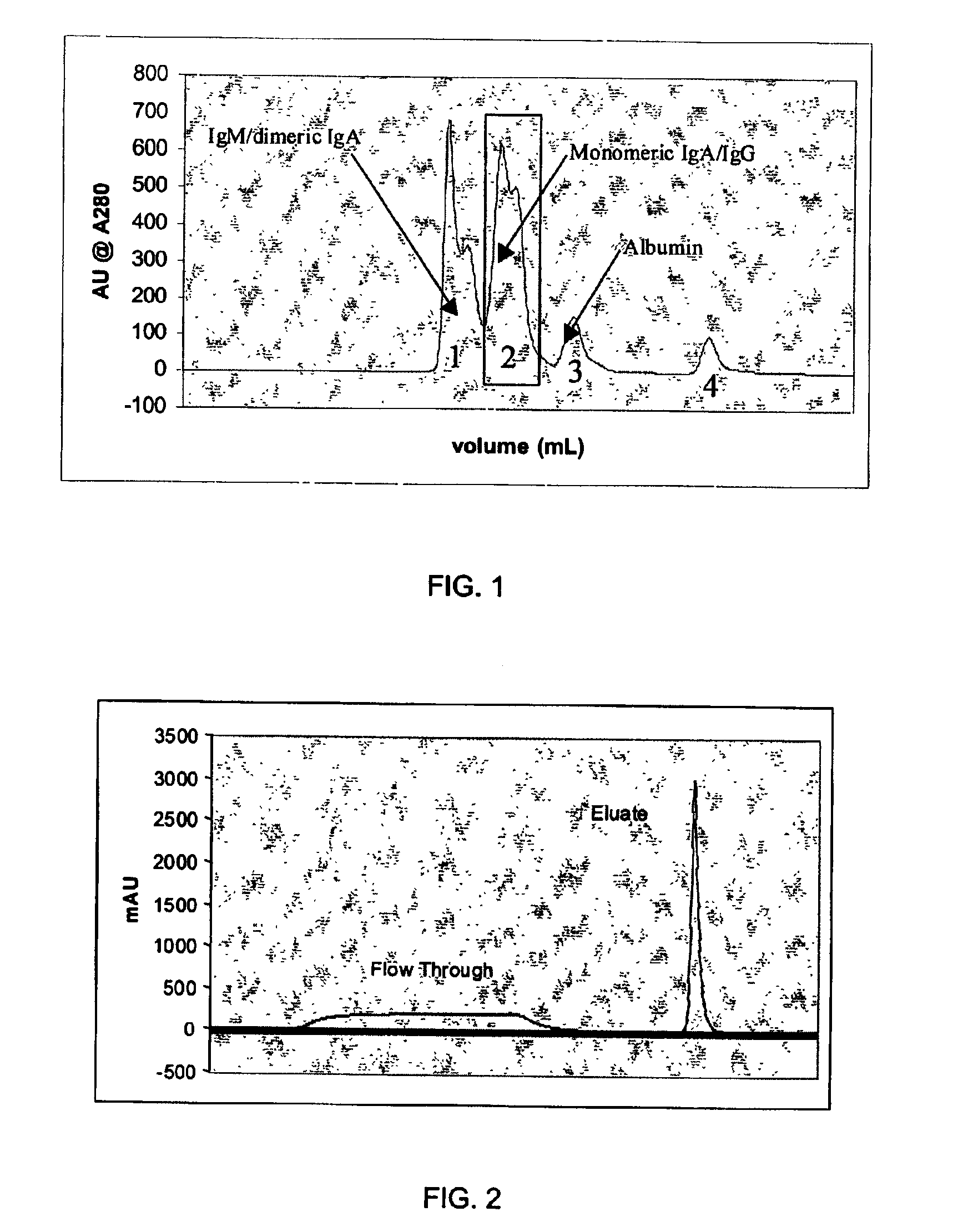Chromatographic method for high yield purification and viral inactivation of antibodies
a chromatographic method and antibody technology, applied in the field of protein purification and virus inactivation/removal, can solve the problems of denatured process stream globulins and generation of contaminant neo-antigens, and achieve the effects of maximizing yield, minimizing post-virus treatment manipulation of gamma globulin solution, and greater than 99% purity
- Summary
- Abstract
- Description
- Claims
- Application Information
AI Technical Summary
Benefits of technology
Problems solved by technology
Method used
Image
Examples
example 1
Purification of IgG from Cohn Fraction II+III Paste
[0052]Fraction II+III paste was solubilized in 12 volumes of 5° C. purified water. The mixture pH was adjusted to pH 4.2 with acetic acid, and mixed for 1 hour. This step put the IgG into solution.
[0053]The mixture pH was then adjusted up to pH 5.2 with NaOH and sodium caprylate (the “pH swing”). Proteins and lipids were precipitated. The mixture was clarified by filtration to remove precipitate which would interfere with virus inactivation. The caprylate concentration was adjusted to 20 mM at pH 5.1, and the mixture was incubated for 1 hour at 25° C. to effect enveloped virus inactivation.
[0054]The mixture was filtered to produce a clear solution for chromatography. The solution conductivity was adjusted to between 2.0 and 3.0 mS / cm using purified water. The pH of the solution was adjusted to 5.0 to 5.2 following the conductivity adjustment.
[0055]The solution was then applied directly to two anion exchange columns (a strong anion e...
example 2
Purification of IgG from Cell Culture Medium
[0059]Cell line growth media containing secreted monoclonal antibodies is first adjusted to the proper pH and conductivity. This accomplished by diafiltering against purified water while adjusting the pH to 4.2 with acetic acid. The conductivity should be less than 1.0 mS.
[0060]Purification of the monoclonal antibody is achieved by following the steps above. The purified monoclonal antibody is then concentrated and final formulated to a pH of 4.2 using glycine, maltose, or other suitable excipients. By formulating at pH 4.2 a liquid solution stable for 2 years at 5° C. can be achieved. This is highly desirable from a commercial standpoint.
example 3
Recovery of IgA and IgM from Cohn Fraction II+III Paste
[0061]The process described in Example 1 was followed and IgG obtained in high yield and purity as described. However, subsequent experimentation revealed that IgA could be eluated from the first anion exchange resin column with a high concentration salt solution, and that IgM could be eluated from the second anion exchange resin column with a similar high concentration salt solution. It is believed that a buffered solution having at least the conductivity of 100 mM sodium chloride would provide similar results. An eluant would have a preferred range of conductivity equivalent to that of 100 to 250 mM sodium chloride. The first anion exchange column is preferably a strong anion exchange resin such as Pharmacia Biotech Q and the second anion exchange column is preferably a weak anion exchange resin such as Pharmacia Biotech ANX.
PUM
| Property | Measurement | Unit |
|---|---|---|
| Fraction | aaaaa | aaaaa |
| Fraction | aaaaa | aaaaa |
| Molar density | aaaaa | aaaaa |
Abstract
Description
Claims
Application Information
 Login to View More
Login to View More - R&D
- Intellectual Property
- Life Sciences
- Materials
- Tech Scout
- Unparalleled Data Quality
- Higher Quality Content
- 60% Fewer Hallucinations
Browse by: Latest US Patents, China's latest patents, Technical Efficacy Thesaurus, Application Domain, Technology Topic, Popular Technical Reports.
© 2025 PatSnap. All rights reserved.Legal|Privacy policy|Modern Slavery Act Transparency Statement|Sitemap|About US| Contact US: help@patsnap.com

